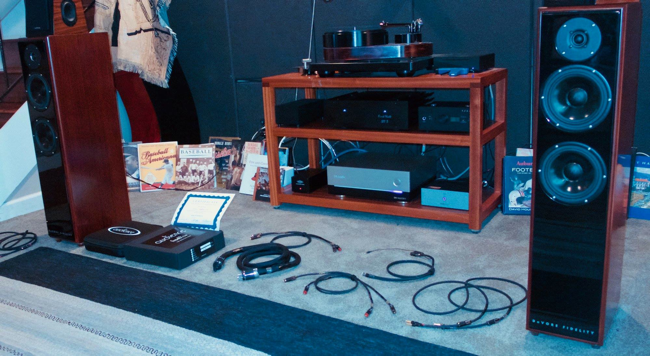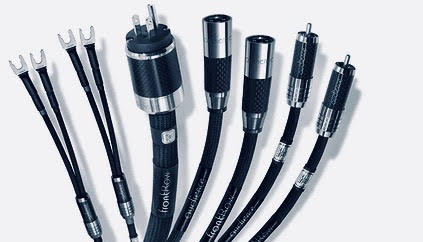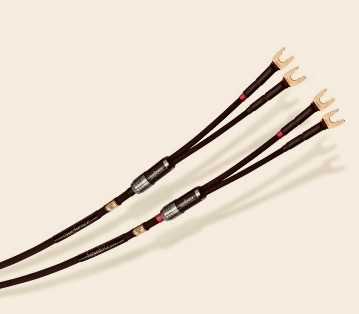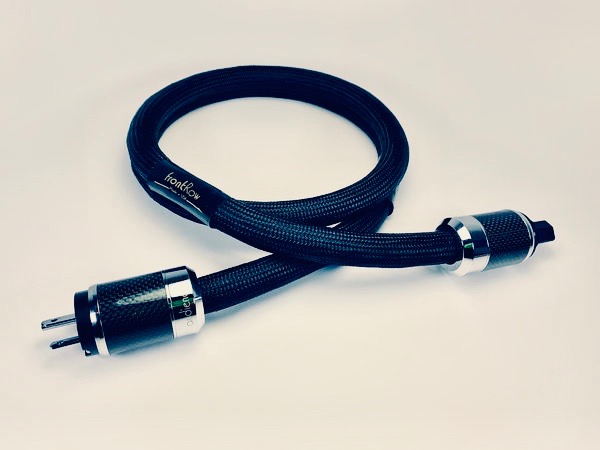
I’ve been an audiophile long enough to remember when we hooked everything up with free wire we were given when we purchased equipment. For those of you audiophiles have no idea what I’m talking about, I swear I’m not making this up. The interconnects were packaged with the electronics, and I remember the salesmen walking over to a spool of 10- or 12-gauge lamp cord and asking how much speaker wire you wanted him to cut off for you. And while the lamp cord and interconnects didn’t sound the best, they were flexible and easy to hook up. That may be where I started, but I have been down a long road with cables. I remember owning some Bob Fulton’s cables, Mark Levinson’s silver cables, Audioquest, Van den Hul, Nordost (including Valhalla), High Fidelity Cables, Audience and many others from brands I can’t recall. Some of these wires were thick enough to be water hoses, and some were heavy enough to lift a lightweight preamp or CD player up in the air. Worst of all, some had connectors that were so heavy they broke the less-sturdy binding posts off of the speakers or amps.
My Experience with Audience Cables
Audience cables have been one of my go-to brands since 2003. I like their sound, and they are flexible and thin. They also have very lightweight connectors. I must confess though, I probably would not have used Au24 cables for so many years if it had not been for a series of interactions with Bob Neil on Audio Asylum in 2003.
When I first compared the AU24s to my Nordost Valhalla cables, I was sure that my Nordost cables had put away another challenger, even though it was a very nice-sounding one. Bob encouraged me to put the Au24 cables in for a week and then go back to the Valhalla cables. I did, and I learned a valuable lesson about the dangers of quick comparisons. While the Valhalla cables were more spectacular wire, over the long run, my system did not sound as much like music with them as they did with the Audience Au24 cables. In the end, I had to agree that the Au24 cables were the best I had heard up to that time. I have since used and reviewed every incarnation of the Au24s through the current and incredible Au24 SX cables.
Audience frontRow Cables
Let’s fast forward now to 2019. On February 1, Audience started shipping their new top-of-the-line frontRow audio cables. This is a complete range of balanced and unbalanced interconnect, phono, digital, speaker and power cables. They are designed around their newest MORRE (Musically Optimized Reduction of Resistive Energies) technologies to deliver “extraordinary new levels of musical accuracy.” Click here to read Audience’s whitepaper about this technology.

Unlike previous Audience cables, these utilize conductive material made from modified 99.9999% Ohno Continuous Cast (OCC) copper or high-purity silver-plated copper depending on the frontRow cable model. According to their press release, “The cables use XLPE (cross-linked polyethylene) dielectric material, chosen for its superior insulating properties and low microphonics, as well as Teflon and other materials. Depending on the model and application, MORRE can use twinaxial, coaxial, proprietary Perfect Lay, Double Cylindrical, Double Helix or other custom-stranded multi-conductor wire geometries. All configurations are designed to maintain maximum signal purity and reduce noise.”
The Setup
I used a frontRow phono cable from the AMG turntable to the DS Audio Master1 Phono Stage. From there, I used frontRow interconnects to the LTA MZ3 preamp and to the Pass Labs XA30.8 amp. Finally, I used a 2.5-meter run of frontRow speaker cables to connect the Pass amp to my DeVore Super Nine speakers. All of the powerChord were Audience frontRow, and they were plugged into the HB Cables PowerSlave Marble Power Distributor, including the one from the wall.
When setting up a whole system, it is such a joy to work with cables that are so flexible and easy to work with. The banana connectors on the speaker cables and the male plugs on the power cables both fit very tightly, which is a good thing, but it does take a little pressure to insert them.
Breaking In the frontRow Cables
Audience breaks in the cables on a cable burner before they send them to you, but they recommend at least another 100 hours before you give them a serious listen. Right out of the box they sounded a little closed in and dark, but after 24 hours they sounded more open. By the fourth day of playing, they sounded nearly as good as they did after two weeks of playing.
Listening to My System
When reviewing the Au24 SX complete cable system I said, “I knew early on in listening to the Audience Au24 SX cables that these were not just an improvement on the Au24 SE cables, but a big step forward in every way.” It doesn’t take very long, however, to see that these frontRow cables aren’t just another version of the Au24 cables or why they left the Au24 SX cables in the lineup. The frontRow cables are a whole new ballgame, not just for Audience cables, but for audio cables. You can find the technical specifications for these cables on the Audience website.
There is one thing for sure, the ‘MORRE’ technology gives you more of (couldn’t help myself) everything you want and some things you didn’t know you wanted. In my system, this resulted in me listening more like I listen to live music. To me, this is a very good thing. When I go to a concert, I don’t think about the soundstage, the detail or even transparency. I listen to how well the group plays. I expect to be entertained and for the music to move me emotionally. So it’s worth having or doing anything that can make recorded music in my system or environment sound more like live music.
I’ve heard my system have more prominent bass, faster bass and bad bass with more slam. What I have never heard before from a system in my room was a bass that sounded so much like it does in real life. Drums, upright basses, electric basses and pianos all played the most believable bass. It allowed the DeVore gibbon Super Nines to have extremely fast bass, but with attack, bloom, air inside the instruments and in the space around them. Whether it was a large pipe organ or a Hammond B3 with a Leslie speaker, there was deep bass, incredible air and power.
Listening to Music

With the Audience frontRow cables in my system, it was much easier to listen to the interplay between the musicians. This was equally true on jazz, rock, bluegrass or classical music. This was especially true when listening to an orchestral piece like Fitz Reiner and the Chicago Symphony’s version of “Rimsky-Korsakov’s Scheherazade”. It was so easy to hear the interplay between the strings and the woodwinds, and it was so beautiful and involving.
This interplay is not the same as detail or soundstage. I’m talking about the musicians and the way I listen to music. To listen to Norman Blake, Jethro Burns, Sam Bush, Vassar Clements, David Holland, Butch Robins, and Tut Taylor’s “Sauerkraut ‘N Solar Energy” is about as far as it gets from “Rimsky- Korsakov’s Scheherazade”. Still, it was so easy to hear interplay between these incredible bluegrass musicians.
The timbre and tone of these instruments as they played together was so smooth to hear and it just made me want to tap my foot and clap my hands. To approach this kind of experience at home requires your system to begin to disappear. Most often this means that the sound doesn’t seem to come from the speakers.
Speakers and Cables
Speakers and the rest of the system show themselves in many other ways though. The amplification and source also come into play. All this comes together to make audio systems sound less like real music and more like a great sound system.
There was something about the way my system sounded with Audience’s frontRow cables that allowed the music to flow from the source through amplification and out of the speakers so that I listened more to the music than to the system. Depending on the recording, it was as if I were sitting in the venue listening to a performance, or listening to good studio recording. I could almost hear the singers and musicians as if they were in the room with me.
Power Cables and Signal Cables

When I first started this review, I put all of the signal and power cables into the system at once. I let them break in for 100 more hours and then listened to them for a few weeks. You have read above how much I liked them.
Then, I began the process of removing them. This is when I often find out the most about the real differences I have heard. The first cable I removed was the frontRow power cable that ran from the wall to the HB Cables PowerSlave Marble Power Distributor. It became quite apparent that the frontRow power cables were superior to both of the cables I compared them to, the Au24 SE power cable and the WyWires Platinum power cable. In both cases, the difference was small, but not insignificant.
As I talked about above, the frontRow power cables made it easier to listen to the music. I tried several combinations of power cables in the system and none were as good as a full set of frontRow power cables. There was one combination that was close enough that I couldn’t tell much difference. That combination was using the Audience frontRow power cables from the wall to the HB Cables PowerSlave Marble Power Distributor and to the Pass Labs XA30.8 amplifier. Then, I ran the Audience Au24 SE medium power cables to the LTA MZ3 preamp, the DS Audio Master1 phono preamp and the AMG turntable.
Next, I swapped the interconnects back to Au24 SX interconnects. The difference was very similar but not as noticeable as with the power cables. Then I swapped speaker cables, and there seemed to be a more significant difference. After a lot of swapping and listening over several days, I decided the best for the money would be the two power cables and the speaker cables. Still, a full run of Audience frontRow cables is the very best.
Conclusion
As I stated in this review, the Audience frontRow cables have put them in a whole new ballgame, not just for Audience cables, but also for all audio cables. Not only are they in a new ballgame, but it’s the World Series, and for the time being, Audience has won and is the champion.
I wish I could afford these cables, but I can’t at the moment. I hope I can figure out a way to get two powerChords. I’ve never reviewed any cables I could recommend as highly as I do the Audience frontRow cables!
Technical Specifications:
Follow the links below to access more technical specifications on these cables.
Price Information:
- 1.0m RCA > DIN phono cable – $3,225 (+$375 per half meter)
- 1.0m RCA > RCA – $3,300 (+375 per half meter)
- 1.0m speaker cable – $4,000 (+$500 per half meter)
- 6 ft. High Power powerChord – $6,700 (+/- $260 per ft.)
- 6 ft. Medium Power powerChord – $6,200 (+/- $240 per ft.)
